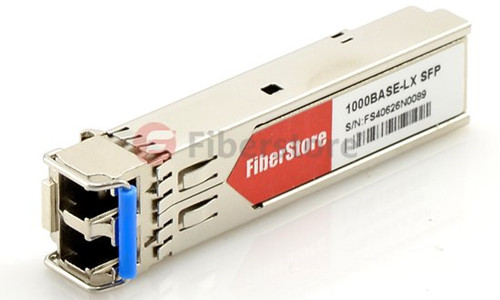SFP optical module is a compact optical transceiver module used in communication field. SFP optical transceivers are designed to support SONET/SDH, Fast Ethernet, Gigabit Ethernet, Fibre Channel and other communications standards. It interfaces a network device motherboard (switch, router, media converter or similar device) to a Fiber Channel or Gigabit Ethernet optical fiber cable at the other end. SFP transceivers are available in a wide range of data rates including 155M, 622M, 1.25G and 2.5G, which allows users to choose the most suitable transceiver for each link. Today’s article will illustrate the most popular 1.25G SFP transceivers.
Description of SFP Transceiver
SFP modules can be divided into different types according to different standard. Here is what you need to know about SFP modules. The transmission distance of a SFP is up to 120km for single-mode and 2km for multimode fiber. The SFP fiber transceiver could be dual fibers with LC connectors, or single fiber with LC or SC connectors. The wavelengths could be 850nm, 1310nm and 1550nm. The 1.25G SFP optical transceiver modules are available in different standard such as 1000BASE-T, 1000BASE-SX, 1000BASE-LX/LH, etc. The following part explains such types.
1000BASE-SX SFP Transceiver
1000BASE-SX SFP transceiver is a cost effective 850nm module supporting dual data-rate of 1.25Gbps/1.0625Gbps. It is compatible with the IEEE 802.3z 1000BASE-SX standard and operates multimode fibers link up to 550 m. The fiber optic transceiver consists of three sections: a VCSEL laser transmitter, a PIN photodiode integrated with a trans-impedance preamplifier (TIA) and MCU control unit. This SFP type (e.g. J4858B) is usually applied for Fiber Channel links, Gigabit Ethernet links, Fast Ethernet links, etc. J4858B (see in Figure 1) is HP 1000BASE-SX SFP that is widely welcomed by overall users.

1000BASE-LX/LH SFP Transceiver
1000BASE-LX/LH SFP transceiver is a high performance 1310nm transceiver for single-mode fibers. It is compatible with the IEEE 802.3z 1000BASE-LX standard and also supports dual data-rate of 1.25 Gbps/1.0625 Gbps with a transmission distance of 10 /15 /20 km. Cisco GLC-LX-SM-RGD (shown in Figure 2) is 1000BASE-LX/LH SFP that can operate on standard single-mode fiber-optic link spans of up to 10 km and up to 550 m on any multimode fibers. HP J4860C is a 1000BASE-LH SFP that can operates over 1550nm for a distance of 70km. Unlike Cisco GLC-LX-SM-RGD SFP, J4860C can support a much longer distance of 70km, which is ideal for long-haul network application.

10/100/1000BASE-T SFP Transceiver
10/100/1000BASE-T SFP Transceiver is compatible with the Gigabit Ethernet standard as specified in IEEE STD 802.3. It supports data rates of 10/100/1000 Mbps, fully satisfying 10/100/10001000BASE-T applications such as LAN 10/100/1000Base-T Fiber Channel links, Gigabit Ethernet over Cat 5 Cable, Switch to Switch Interface, Router/Server interface, etc.
Why Choose Compatible SFP Module
We have introduced several SFP modules above including the HP SFPs. The original SFP optical transceivers are very expensive, the simple solution to this is to find a reliable OEM vendor. Besides saving cost, there are many others reasons that you should choose to purchase a compatible SFP, SFP+ or XFP fiber optic transceiver. For example in a scenario where gigabit speed is required to run across a point-to-point link, the distance between the link length is assessed and an appropriate SFP transceiver module native to the host device is chosen. If a HP platform was in situation, then the selection of module will be limited by among the following: 550 meter (J4858B), 10km (J4859B), 40km (JD061A) or the maximum 70km (J4860C). Using a compatible SFP you can choose from a variety of distance limits from 550meters up to 100km in numerous increments with distances of 160km being achievable on the top product lines.
Another advantage of use compatible SFP transceivers is the freedom to tailor the transceiver to your individual requirement. Custom serial numbers can be added both to the product label and also hard coded to the device itself. Latches can be color coded for high density link identification Fiberstore also provide a recoding service in China, this specific service means existing SFP's can be adapted if the host device is to be changed. In some instances, even cross-device compatibility is quite possible.
Conclusion
Because of its high performance and small size, SFP transceiver replaces the former GBIC module and becomes the most used fiber optic transceiver module in the telecommunication industry. Currently, many optical vendors supply optical transceiver modules. Fiberstore, as a professional telecom manufacturer and supplier, offers a full range of SFP optical transceivers that are 100% compatible with large brands. We are committed to provide high-quality products and long-term customer services to our customers. Any interested in our products, you can contact us directly.







